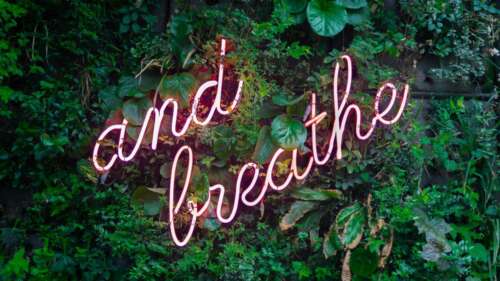
Stress is insidious. And most of us aren’t even aware that we are stressed or living with chronic stress until something forces us to stop and take note. But the easiest way to tap into how we are feeling is to look at the breath. And breath is everything . If we can learn how to tune in to our breath, it tells us everything that is happening within our bodies. Here are some simple breathing exercises we can do anywhere – at our desk, on a walk, waiting in line, in the shower, etc.
Beginner Breathing Technique: Begin by taking exaggerated breaths: a deep three-second inhale through your nose, hold your breath for two seconds, and breathe out through your mouth for four seconds. When your mind wanders (and it will), gently bring your attention back to your breath. Don’t worry if your mind wanders just bring it back when you notice it has wandered. Repeat. Try working your way up to about 15 minutes a day.
Diaphragmatic Breathing: Abdominal breathing, or belly breathing, slows your heartbeat and can also lower blood pressure. This exercise targets the vagal nerve and calms the body’s fight or flight response. Lie on your back on a flat surface with your knees bent (if needed, place a pillow under your knees for support). Put one hand on your upper chest and one below your rib cage, so you can feel your diaphragm move as you breathe. Inhale slowly through your nose, feeling your stomach move out against your hand, then tighten your stomach muscles as you exhale through your mouth.
Practice this type of breathing for five to 10 minutes, three to four times a day. As you get more comfortable with this method, you can even place a book on your stomach to make it a little more challenging (and effective).
Alternate Nostril Breathing: This technique is a very common yogic breath control practice. It’s thought to harmonize the two hemispheres of the brain and, as a result, balances your physical, mental and emotional well-being.
Begin by sitting straight up in a comfortable seat, your left palm comfortably in your lap. Lift your right hand to your face so that your pointer and middle fingers rest between your eyebrows. Close your eyes and inhale and exhale deeply through your nose. Then, close your right nostril with your right thumb while inhaling through your left nostril. After that, close your left nostril with your ring finger so both nostrils are held closed for a moment, then open your right nostril and exhale slowly through your right side. Inhale through your right nostril, then hold both nostrils closed with your ring finger and thumb. Open your left nostril and exhale slowly through your left side. Repeat five to 10 times once a day, or as desired.
4 – 7 – 8 Breathing: This technique is based on the yogic technique pranayama. Sit with your back straight and place the tip of your tongue behind your upper front teeth. You’ll need to keep it there throughout this breathing exercise. Then exhale through your mouth, making a “whoosh” sound.
- Close your mouth and inhale through your nose to the silent count of four.
- Hold your breath for a count of seven.
- Open your mouth and exhale through it, making a whoosh sound to a count of eight.
Repeat this cycle three more times, with a recommended practice at least twice a day.
Body Scan Breathing: This involves doing deep breathing while focusing your attention on different parts of your body, from head to toe, starting with your forehead and ending at the muscles in your feet. It can be done lying down or sitting, whatever’s most comfortable for you. Close your eyes and pay attention to your body’s position. As an example, pay attention to the weight of your body against the chair or the floor.
Take a deep breath, visualizing oxygen entering your body as you inhale and focusing on a sense of relaxation as you exhale. Focus on the sensations of your feet touching the floor or of your legs pressing against the chair. Work your way up to bring attention to other areas of your body. How does your back feel against the chair? Are your hands or stomach tense? (If so, try to relax them.) Loosen your shoulders and let your jaw relax. Take one more moment to notice your whole body, take a breath and open your eyes
Initially, start with short periods of time of three to five minutes before working your way up to at least 20 minutes at least three times a week. The more you practice body scan, the more benefits you’ll enjoy.
Take your time with these and be patient with yourself. A new technique or exercise takes time to learn and practice. Maybe try setting an alarm for a five minute practice session, while sitting at your desk and slowly build up the time. Consistent short practice sessions will bear better results. Pause, take a deep breath and smile. You’re helping your body heal from chronic stress.

